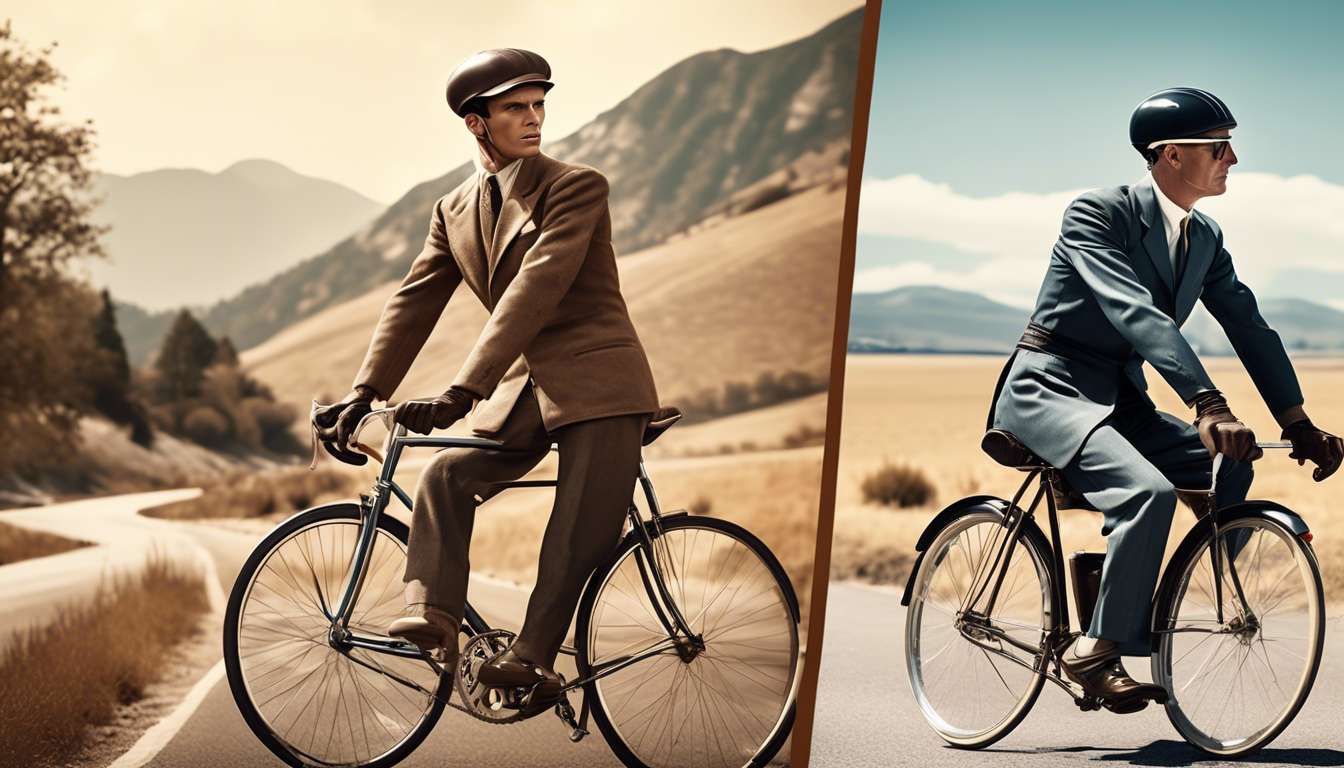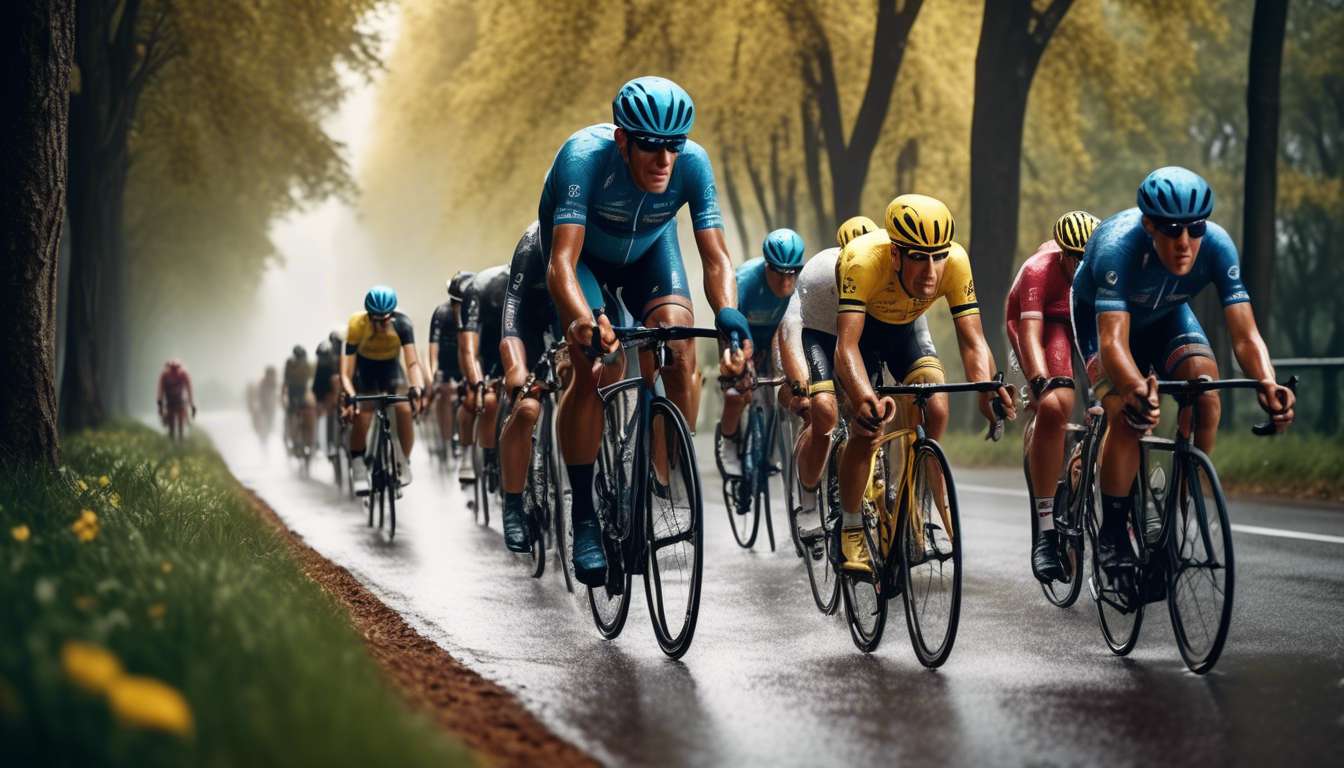As cycling enthusiasts, we are constantly drawn to the evolution of the Tour de France, a spectacle that has captivated audiences for over a century. In comparing the modern Tour de France with its classic era, we embark on a journey through time, examining how the race has transformed from its humble beginnings into the high-tech, globally broadcasted event it is today.
Innovations in the Modern Era:
-
Equipment:
- Modern bicycles are made from lightweight materials such as carbon fiber, enhancing speed and agility.
- Advanced aerodynamics and cutting-edge gear systems provide cyclists with a competitive edge.
-
Training Techniques:
- Athletes now use data analytics and personalized training regimens to optimize performance.
- Nutrition and recovery strategies are meticulously planned to ensure peak physical condition.
-
Race Strategies:
- Teams utilize sophisticated tactics, including drafting and time trials, to outmaneuver opponents.
- The role of technology, such as real-time communication with team directors, influences race dynamics.
Paying Homage to the Classic Era:
The early days of the Tour de France were marked by grit and raw endurance. Pioneers of the race tackled rugged terrains with basic equipment, relying on sheer determination and resilience.
Acknowledging Legends and Contemporary Athletes:
We acknowledge the legends who paved the way, setting records and inspiring future generations. Today’s athletes continue to push the boundaries of human endurance, setting new benchmarks in cycling history.
By exploring these two distinct eras, we aim to appreciate the rich history of the Tour de France while celebrating the advancements that have brought it into the 21st century.
Evolution of Cycling Technology
Over the years, significant advancements in cycling technology have transformed both the equipment and strategies used in the Tour de France. These innovations bring us closer to the athletes and their remarkable achievements, making us part of a community that values progress.
Modern bikes are:
- Lighter
- More aerodynamic
These features allow riders to slice through the air with minimal resistance. Such technological breakthroughs make us feel like we’re part of a shared evolution, witnessing the incredible potential of human ingenuity.
Our race strategies have also evolved, leveraging technology to optimize performance. We now use real-time data to adjust our tactics on the fly, ensuring that every pedal stroke is as efficient as possible.
This sense of collective progress, through advancements in cycling technology and refined strategies, strengthens our bond as fans and enthusiasts. We’re united in our passion, celebrating each technological leap that enhances the spectacle of the Tour de France, connecting us to a larger cycling family.
Transformation in Training Methods
In recent years, we’ve witnessed a dramatic shift in how cyclists prepare for the Tour de France, incorporating cutting-edge techniques that maximize performance and endurance. As a unified community of cycling enthusiasts, we celebrate the innovative training methods that align with our shared passion for excellence.
Embracing advancements in cycling technology, we now utilize power meters and advanced analytics to tailor workouts with unprecedented precision. These tools allow us to track our performance in real-time, identifying areas for improvement and ensuring we train smarter, not harder.
Our training methods have evolved from intuition-based practices to data-driven regimens, creating a more inclusive atmosphere where every rider feels empowered to reach their potential. Key components of our training focus include:
- Nutrition
- Recovery
- Specialized training camps
These elements foster camaraderie and shared growth among cyclists.
As we push the boundaries, we’re not just preparing for a race; we’re part of a transformative journey, constantly redefining what it means to excel in the world of cycling.
Shift in Race Strategies
In recent years, we’ve seen a significant evolution in how teams approach their race strategies for the Tour de France, focusing on versatility and adaptability to handle the dynamic conditions of modern cycling.
With advancements in cycling technology and innovative training methods, we can fine-tune our tactics to suit every stage of the race. It’s no longer just about raw power; it’s about using data and technology to strategize effectively.
Our teams rely on cutting-edge cycling technology, such as:
- Power meters
- Aerodynamic gear
These tools allow us to analyze performance in real-time. This data guides our decisions, whether we’re climbing a mountain or sprinting through flat terrain.
Training methods have also evolved, emphasizing not just physical prowess but:
- Mental resilience
- Tactical awareness
We’re a community driven by innovation, bound by our shared passion for cycling. Together, we push the boundaries of what’s possible, embracing change and continuously refining our approach to achieve victory.
Legacy of Early Tour Pioneers
The brave riders of the early Tour de France laid the foundation for today’s race, their spirit and tenacity inspiring generations to come. We owe much to these pioneers who rode without the benefits of modern cycling technology. They tackled grueling stages on rudimentary bicycles, relying on sheer willpower and basic training methods to compete. Their journeys pushed the boundaries of what was considered humanly possible and set the stage for the advancements we see today.
Back then, race strategies were simple but effective. Riders depended on their instincts and camaraderie, often forming alliances to navigate the harsh terrains.
As we’ve adopted advanced gear and sophisticated training regimes, we still carry the lessons learned from their experiences. This connection to the past unites us, reminding us of shared struggles and triumphs.
By honoring these early pioneers, we embrace our roots, fostering a sense of belonging and continuity in the ever-evolving world of competitive cycling.
Tribute to Cycling Legends
Countless legends of the Tour de France have left an indelible mark on the sport, inspiring us with their remarkable achievements and relentless pursuit of excellence. These icons have not only shaped the way we view cycling but have also influenced the evolution of cycling technology, training methods, and race strategies.
As a community of enthusiasts, we feel a deep connection to these pioneers who paved the way for future generations.
Advancements in Cycling:
- Bicycles have transformed from heavy steel frames to lightweight carbon machines.
- Training methods have evolved, allowing riders to optimize their physical and mental endurance.
Legendary Cyclists:
Legends like Eddy Merckx and Bernard Hinault didn’t just rely on raw talent; they adapted their race strategies to outsmart and outpace their competitors.
Together, we cherish the sense of camaraderie these legends instilled in us. They remind us that the Tour de France is more than just a race—it’s a journey shared by all who love cycling.
Benchmarking Human Endurance
The Tour de France pushes the limits of human endurance, showcasing the incredible physical and mental strength required to complete this grueling race.
Cycling Technology Evolution
We marvel at the evolution of cycling technology, which has transformed bikes into precision machines. Advanced materials and aerodynamic designs make each pedal stroke more efficient, allowing us to reach new heights in endurance.
Training Methods
Training methods have evolved alongside technology. We now utilize:
- High-altitude training camps
- Personalized regimens
These methods maximize our physiological capabilities, ensuring we’re not just surviving the race but thriving through its challenges.
Race Strategies
Race strategies have also become more sophisticated. We analyze:
- Wind patterns
- Terrain
This allows us to draft effectively and conserve energy for crucial stages. Such strategic approaches enable us to maintain peak performance across all 21 stages.
Community and Progress
As a community of enthusiasts, we share in the triumphs of modern athletes, understanding that every advance in technology, training, and strategy is a step forward for all of us.
Impact of Data Analytics
Data analytics revolutionize how we approach the Tour de France, offering insights that enhance our performance and strategic decisions. We’re part of a community that thrives on innovation, and data plays a crucial role in this evolution.
With advanced cycling technology, we can measure every aspect of our training methods, from heart rate variability to power output. These metrics allow us to tailor our workouts, maximizing efficiency and improving our overall endurance.
In the heat of competition, data-driven race strategies are our secret weapon. We analyze real-time data to adapt to every twist and turn of the course. By understanding our competitors’ strengths and weaknesses, we’re able to make informed decisions, whether it’s:
- Attacking on a climb
- Conserving energy for a sprint finish
Collectively, we’re embracing these tools, creating a shared sense of purpose and progress. As we pedal forward, data analytics not only transforms our individual performances but also unites us in our quest for victory.
Influence of Modern Innovations
Modern innovations in the Tour de France have reshaped our approach to the race, enhancing both performance and engagement.
We’ve embraced cutting-edge cycling technology, such as:
- Lightweight carbon frames
- Aerodynamic helmets
These advancements allow us to ride faster and more efficiently, making us feel part of a community pushing the boundaries of what’s possible in cycling.
Our training methods have evolved as well, incorporating data-driven insights and virtual simulations. We now:
- Tailor our workouts to optimize endurance and recovery
- Ensure we’re in peak condition when the race begins
This shared commitment to progress brings us closer together as athletes and fans, united in our pursuit of excellence.
Race strategies have also adapted, with teams utilizing real-time data to make quick decisions. We can:
- Analyze competitors’ performances
- Adjust our tactics to gain a competitive edge
This strategic approach not only enhances our sense of camaraderie but also deepens our connection to the sport we love.
How has the global audience and fan engagement changed from the classic era to the modern Tour de France?
As we analyze the evolution of fan engagement in the Tour de France, we notice a significant shift in the global audience’s interest.
In recent years, advancements in technology and social media have allowed fans to connect with the race like never before. This enhanced engagement has undoubtedly contributed to the growing popularity and global reach of the Tour de France.
Key factors influencing this shift include:
- Live updates
- Interactive platforms
- Behind-the-scenes content
These elements have fostered a sense of community among fans worldwide, further solidifying the Tour de France’s status as a globally celebrated event.
What role has media coverage played in the popularity and evolution of the Tour de France over the years?
Media coverage has been crucial in shaping the popularity and evolution of the Tour de France over the years. It allows us to connect with the race, its riders, and the stories behind the competition.
Through various platforms, we have been able to witness the excitement, drama, and triumphs of the event. This fosters a sense of belonging and community among fans worldwide.
The coverage continues to play a vital role in keeping us engaged and invested in the Tour de France.
How have the economic aspects, such as sponsorships and prize money, evolved from the classic era to the modern day?
Sponsorships and Prize Money Evolution
Sponsorships and prize money have significantly transformed over time.
In the past, they were more modest, with fewer sponsors involved. Nowadays, the economic aspects of the Tour de France are massive, attracting big sponsors and offering substantial prize money.
Impact of Evolution
This evolution has brought:
- Greater visibility
- More resources for teams
- Increased competitiveness
The economic landscape has truly shifted, impacting the sport’s dynamics and appeal to fans worldwide.
Conclusion
In conclusion, the modern Tour de France has undeniably evolved from its classic era counterpart.
With advancements in:
- Technology
- Training methods
- Race strategies
Today’s riders push the boundaries of human endurance like never before.
While paying tribute to the early pioneers and cycling legends, the influence of data analytics and modern innovations continues to shape the future of this iconic race.
The Tour’s legacy stands as a testament to the relentless pursuit of excellence in the world of cycling.




